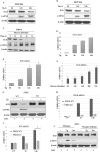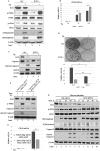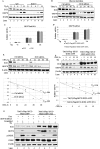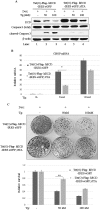Mammalian ECD Protein Is a Novel Negative Regulator of the PERK Arm of the Unfolded Protein Response
- PMID: 28652267
- PMCID: PMC5574048
- DOI: 10.1128/MCB.00030-17
Mammalian ECD Protein Is a Novel Negative Regulator of the PERK Arm of the Unfolded Protein Response
Abstract
Mammalian Ecdysoneless (ECD) is a highly conserved ortholog of the DrosophilaEcd gene product whose mutations impair the synthesis of Ecdysone and produce cell-autonomous survival defects, but the mechanisms by which ECD functions are largely unknown. Here we present evidence that ECD regulates the endoplasmic reticulum (ER) stress response. ER stress induction led to a reduced ECD protein level, but this effect was not seen in PKR-like ER kinase knockout (PERK-KO) or phosphodeficient eukaryotic translation initiation factor 2α (eIF2α) mouse embryonic fibroblasts (MEFs); moreover, ECD mRNA levels were increased, suggesting impaired ECD translation as the mechanism for reduced protein levels. ECD colocalizes and coimmunoprecipitates with PERK and GRP78. ECD depletion increased the levels of both phospho-PERK (p-PERK) and p-eIF2α, and these effects were enhanced upon ER stress induction. Reciprocally, overexpression of ECD led to marked decreases in p-PERK, p-eIF2α, and ATF4 levels but robust increases in GRP78 protein levels. However, GRP78 mRNA levels were unchanged, suggesting a posttranscriptional event. Knockdown of GRP78 reversed the attenuating effect of ECD overexpression on PERK signaling. Significantly, overexpression of ECD provided a survival advantage to cells upon ER stress induction. Taken together, our data demonstrate that ECD promotes survival upon ER stress by increasing GRP78 protein levels to enhance the adaptive folding protein in the ER to attenuate PERK signaling.
Keywords: ECD; ER; GRP78; PERK; UPR; cell survival.
Copyright © 2017 Olou et al.
Figures







Similar articles
-
The Human Cytomegalovirus Endoplasmic Reticulum-Resident Glycoprotein UL148 Activates the Unfolded Protein Response.J Virol. 2018 Sep 26;92(20):e00896-18. doi: 10.1128/JVI.00896-18. Print 2018 Oct 15. J Virol. 2018. PMID: 30045994 Free PMC article.
-
Effects of muscular dystrophy, exercise and blocking activin receptor IIB ligands on the unfolded protein response and oxidative stress.Free Radic Biol Med. 2016 Oct;99:308-322. doi: 10.1016/j.freeradbiomed.2016.08.017. Epub 2016 Aug 20. Free Radic Biol Med. 2016. PMID: 27554968
-
TBL2 is a novel PERK-binding protein that modulates stress-signaling and cell survival during endoplasmic reticulum stress.PLoS One. 2014 Nov 13;9(11):e112761. doi: 10.1371/journal.pone.0112761. eCollection 2014. PLoS One. 2014. PMID: 25393282 Free PMC article.
-
The Role of the PERK/eIF2α/ATF4/CHOP Signaling Pathway in Tumor Progression During Endoplasmic Reticulum Stress.Curr Mol Med. 2016;16(6):533-44. doi: 10.2174/1566524016666160523143937. Curr Mol Med. 2016. PMID: 27211800 Free PMC article. Review.
-
Molecular signal networks and regulating mechanisms of the unfolded protein response.J Zhejiang Univ Sci B. 2017 Jan.;18(1):1-14. doi: 10.1631/jzus.B1600043. J Zhejiang Univ Sci B. 2017. PMID: 28070992 Free PMC article. Review.
Cited by
-
Easi-CRISPR for creating knock-in and conditional knockout mouse models using long ssDNA donors.Nat Protoc. 2018 Jan;13(1):195-215. doi: 10.1038/nprot.2017.153. Epub 2017 Dec 21. Nat Protoc. 2018. PMID: 29266098 Free PMC article.
-
Xrp1 governs the stress response program to spliceosome dysfunction.Nucleic Acids Res. 2024 Mar 21;52(5):2093-2111. doi: 10.1093/nar/gkae055. Nucleic Acids Res. 2024. PMID: 38303573 Free PMC article.
-
The Mammalian Ecdysoneless Protein Interacts with RNA Helicase DDX39A To Regulate Nuclear mRNA Export.Mol Cell Biol. 2021 Jun 23;41(7):e0010321. doi: 10.1128/MCB.00103-21. Epub 2021 Jun 23. Mol Cell Biol. 2021. PMID: 33941617 Free PMC article.
-
SHP2 regulates adipose maintenance and adipocyte-pancreatic cancer cell crosstalk via PDHA1.J Cell Commun Signal. 2023 Sep;17(3):575-590. doi: 10.1007/s12079-022-00691-1. Epub 2022 Sep 8. J Cell Commun Signal. 2023. PMID: 36074246 Free PMC article.
-
Ecdysoneless Overexpression Drives Mammary Tumorigenesis through Upregulation of C-MYC and Glucose Metabolism.Mol Cancer Res. 2022 Sep 2;20(9):1391-1404. doi: 10.1158/1541-7786.MCR-22-0122. Mol Cancer Res. 2022. PMID: 35675041 Free PMC article.
References
MeSH terms
Substances
Grants and funding
LinkOut - more resources
Full Text Sources
Other Literature Sources
Molecular Biology Databases
Research Materials
Miscellaneous
